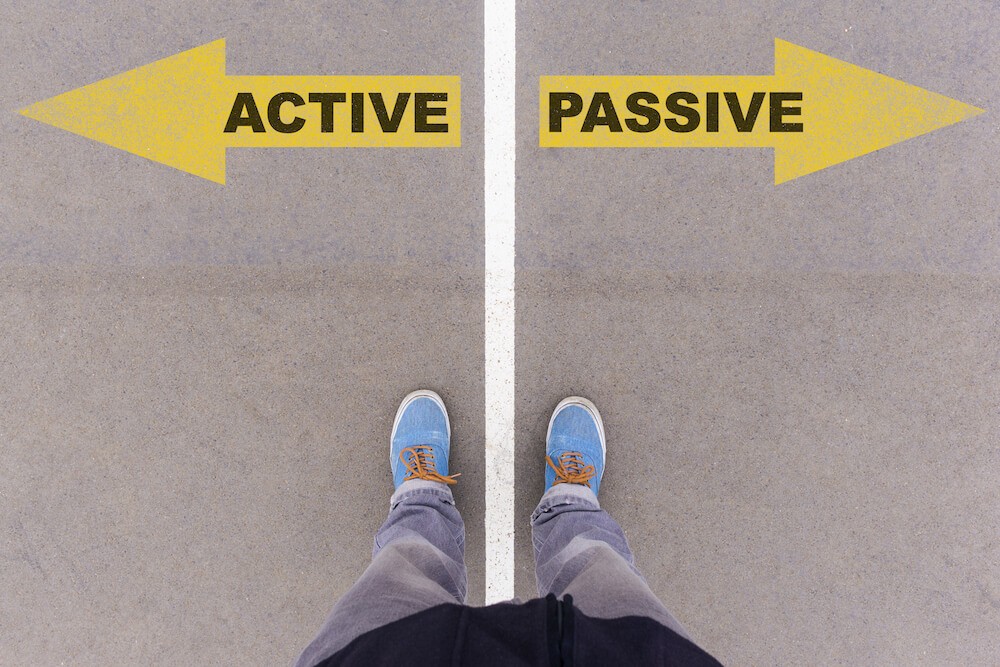We learn 10% of what we read, 20% of what we hear, 30% of what we see… This hierarchy of the effectiveness of learning methods has long been part of the large family of neuromyths. However, it allows us to point out an important element: it is not so much the nature of the activity that promotes a learning outcome, it is the cognitive and social engagement of students in a learning task – combined with reflection on this learning (we learn better to do something when we understand what we are doing and why we are doing it) – which allow them to move from a level of learning on the surface to a level of learning in-depth and thus be part of an active learning process.
Active and passive learning: what are we referring to?
Active learning refers to learner-centered pedagogical approaches. These approaches demonstrate, on the part of teachers, the desire to design learning activities aimed at involving students dynamically in the learning process. As Mikaël Declerck – researcher at UCLouvain – recently underlined during a summary presentation organized at the Louvain Learning Lab, active learning is characterized by the fact of:
- involve the student in the construction of learning,
- engage the student in an in-depth treatment of the material,
- build learning through interaction (with the teacher and with other students),
- view learning as an evolution of knowledge and skills.
- In contrast, passive learning refers to teacher-centered pedagogical approaches, favoring a one-sided and transmissive mode of teaching. And while research shows overall a greater effect of active learning methods on passive learning in terms of effectiveness on deep learning, three major questions remain unanswered:
- What do we really mean by active learning?
Is it about setting students in motion or enabling them to better engage in a learning activity? Isn’t their confusion between action in the physical sense (manipulation of objects, movement) and activity in the cognitive sense of the term? How then to define the degree of commitment necessary to allow students to learn in-depth? What are the manifestations of engagement in a learning activity? To be visible, is active learning reserved for group activities? Which activities to favor?
- Is it reasonable to limit ourselves to a simple dichotomy (“active learning” vs. “passive learning”)?
As in many contexts, the simple categorization between black and white is not sufficient: during the same session, a variety of experiences and learning situations can be offered to the students. Rather than tidying up in restricted and reductive boxes, wouldn’t we try to think in terms of dimensions and continuum?
- Is active learning necessarily linked to the learning activities offered to students?
It is often assumed that the activity proposed by the teacher determines the level of depth of learning. But is it not reasonable to think that how the student interacts with the teaching material also has a role to play in the target level of learning?
Active learning and cognitive engagement modes: meet Michelene Chi
Michelene Chi is a cognitive scientist, professor, and director of the Learning and Cognition Lab at Arizona State University. She is mainly interested in issues related to active learning, and how students engage concretely with learning materials. Although she supports the idea of further promoting active learning, Chi identifies three practical obstacles faced by teachers:
- The recommendations made to them are often too vague and too broad to be implemented in a concrete way in their courses,
- Teachers have few resources at their disposal to decide on the best active learning activities to integrate into their systems,
- Few guidelines exist for teachers to adapt their existing teaching to further promote active learning.
- To overcome these obstacles, Chi and her team embarked on a vast substantive task: to identify the existing scientific literature on active learning and to refine its characteristics. His goal ? Provide teachers with clear principles to improve their practice and promote deep learning By reviewing the studies carried out on the subject, they therefore examined:
- how students engage cognitively in different activities and how they use learning materials (participate in a lecture, read a book, watch a video, etc.),
- the links between these modes of cognitive engagement and observable behaviors, openly expressed by students when they were learning.
- Ultimately, four modes of cognitive engagement (and their associated behaviors) emerge through the ICAP model . In this video, Michelene Chi shares the results of her work at the Knowledge Forum organized in 2016 by the AERA (American Educational Research Association):
- Overcoming the dichotomy between active and passive learning: the 4 modes of cognitive engagement of the ICAP model
- The objective of the ICAP model is to broaden the notion of traditional active learning by proposing a continuum made up of four main modes of cognitive engagement : these are the modes of passive , active , constructive and interactive engagement . These are integrated into a hierarchy (I> C> A> P), each mode of engagement predicting a different and gradual level of learning , ranging from a surface learning level ( passive and active modes ) to a level of in-depth learning ( constructive and interactive modes ).
- Passive mode of engagement
In the passive engagement mode, learners are oriented towards receiving information from the learning material. In this context, they demonstrate limited cognitive engagement. No behavior expressed on their part makes it possible to certify that they appropriate the material. Simply listening to a teacher give a lesson, watching a video without taking notes, reading a book without highlighting anything … is part of this model of cognitive engagement, hence the fact that it is considered “passive”.
Without claiming that it is impossible to learn something in this mode, he predicts a rather low level of learning in the long term (surface learning). In most teaching and learning contexts (whether online or face-to-face), it is the mode of cognitive engagement that we will try to avoid as much as possible. At the very least, if we want to promote learning outcomes that go beyond the intentions of knowledge or information.
- Active engagement mode
In the active engagement mode, learners are oriented towards manipulating information from the learning material. In this context, learners’ cognitive engagement can be considered “active” from the moment it implies a certain form of action on their part: it requires the exercise of sustained attention and the selection of information. Interacting with the learning material, sometimes in very different ways, comes under this scenario, for example:
- point out part of the material on the board,
- highlight and annotate important passages in a text,
- pause a video and go back to replay a passage,
- copy the steps for solving a problem …
- This is the minimum level of cognitive engagement that we would like learners to access. It can be encouraged explicitly by the teacher and through the learning materials offered. It is necessary for individual work and can be mobilized even during a formal teaching activity.
- Mode of constructive engagement
In the constructive engagement mode, learners are oriented towards the transformation and production of information that is not provided basically in the learning material. In this context, the learning results should go beyond the simple manipulation of the previous model to generate new ideas, new knowledge, new inferences, which go beyond the information given to the learners. Among other examples of this model of cognitive engagement, let us note the fact of:
- represent content visually (in the form of a diagram, diagram, sketchnote, etc.),
- study a subject by making links with other parts of the course (or even other courses),
- create a mind map or a concept map to structure the different parts of a subject,
- achieve a synthesis by inducing hypotheses and relationships …
- At this point, there is a clear shift from surface learning to deep learning . It is likely that, by promoting a mode of constructive engagement, the student will be in a much better position to appropriate content in an efficient and sustainable manner.
NB Even if not explained directly in the ICAP model, we find here links with well-known learning strategies (such as the practice of retrieval, elaboration, interleaving, concrete exemplification, and double coding).






It’s impressive that you are getting ideas from this paragraph as well as from our discussion made here.
Feel free to surf to my web blog 12
Some really interesting info , well written and broadly user pleasant.